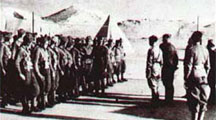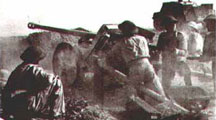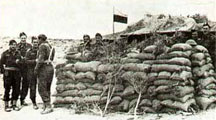| Poland’s
Bravest Sons
By Mike Bennighof, Ph.D.
January 2013
With the fall of Poland, tens of thousands
of Polish soldiers filtered their way to France
to resume the fight against fascism. Hundreds
of others headed south through the Balkans
to the French colony of Syria, where they
also began to organize as part of the Polish
army in exile. When French resistance collapsed
in mid-June 1940, the Polish army of over
50,000 hard-fighting exiles almost overnight
was reduced to the single partially-formed
brigade in Syria.
Gen. Wladyslaw Sikorski authorized the brigade
in December 1939, to the dismay of French
chief of staff Gen. Maurice Gamelin. The French
wanted all Polish soldiers concentrated in
France, and complained that they had neither
the facilities nor the weapons available in
Syria. Finally in the spring of 1940 they
relented and turned over a former Foreign
legion barracks near Homs. The Polish Carpathian
Brigade officially joined the French Army
of the Levant in April 1940, and late in the
month several hundred Polish officers and
soldiers arrived from internment camps in
Romania. A steady stream came from Romania,
the troops officially “escaping”
from Romanian authorities eager to see responsibility
for feeding and housing them sail away with
them.
| 
Polish volunteers muster in Homs, Syria.
|
Most of the soldiers who arrived at Homs
had served in the 1939 campaign; a handful
of Poles resident in Syria volunteered and
several dozen Polish members of the Foreign
Legion obtainde rleeases to join the brigade.
Kopanski also accepted an Iranian who spoke
no Polish but was eager to fight the Nazis.
An ambitious program called for a five-battalion
brigade of almost 7,000 men including artillery
and engineers, but the unit had only reached
about half that strength when France asked
for an armistice in June. Few weapons beyond
Lebel rifles had been issued, and the brigade
was well short of its authorized allotments
of horses, vehicles and artillery.
The French administration in Syria supported
the new Vichy regime in France, and demanded
the Poles disarm and enter an internment camp
in Beirut. With the connivance of French Col.
Rene de Larminat, the brigade’s liaison
officer and a staunch anti-fascist, Col. Stanislaw
Kopanski led his troops over the border into
British-ruled Palestine. Several hundred die-hard
Frenchmen came along as well.
The British inducted the brigade into their
own service, reorganizing it along British
lines as a standard infantry brigade. British
weapons only came slowly, and at one point
the British even asked the Poles to hand over
some of the French-made anti-tank guns they
had spirited out of Syria. British equipment
only arrived in September 1940, along with
a promotion for Kopanski to general. The next
month the Poles moved up to Alexandria as
Italian troops invaded Egypt, performing guard
duty and coast defense. By December, strength
was up to roughly 5,000 and the brigade officially
became the “Carpathian Independent Brigade
group.”
Earmarked for action in Greece in early 1941,
Kopanski refused to let his battalions go
into battle piecemeal, attached to British
or Australian brigades. That delayed Polish
deployment and probably saved the brigade
from destruction. The Poles’ artillery
and vehicles had already been loaded aboard
ships but had not departed Alexandria when
German mountain and panzer divisions crushed
the Greeks and the Allied units sent to help
them. The brigade disembarked and a few weeks
later moved up to Mersa Matruh in western
Egypt to protect the massive Allied supply
depot there.
In June, British forces attacked Vichy French-held
Syria and ordered the Polish brigade to move
to the colony in support. Sikorski would not
allow Polish soldiers to fight French ones,
citing the centuries-old alliance between
the two freedom-loving peoples, and ordered
Kopanski to stay put. The British then selected
the brigade to move to the besieged fortress
of Tobruk to relieve part of the Australian
garrison there.
| 
For God and Poland. Mass is celebrated
near Gazala; note the wide spacing in
case of enemy artillery fire.
|
Over a week’s time in mid-August, seven
nightly convoys brought the Carpathian Brigade
into Tobruk. They replaced the 18th Australian
Brigade, plus an Indian cavalry regiment and
a British artillery regiment. The Diggers
found the Poles to share their disdain for
the English, and gleefully turned over their
“bush artillery” and other heavy
weapons to the Polish troops rather than send
them to the fortress command as procedures
demanded.
The Poles skirmished nightly with the Italian
17th “Pavia” Infantry Division,
and held 20 kilometers with just four battalions
(three infantry and one reconnaissance). Over
the next several weeks Kopanski received two
more to help flesh out his lines: an Australian
infantry battalion and the 11th Czech Infantry
Battalion. Polish troops spent almost their
entire time in the line, much longer than
Australian or British units had done.
The Allied Operation Crusader offensive broke
through to the fortress in late November,
with the Axis starting a withdrawal on 7 December.
The Poles fought off an Italian attack, and
went over to the offensive themselves on the
night of the 9th, taking Medauar Hill in heavy
fighting. Attached to 2nd New Zealand Division,
they spearheaded the attack on the Gazala
line on the 15th and 16th, breaking the Axis
positions and starting the enemy on a rapid
retreat.
| 
Polish gunners turn their “bush
artillery” on Medauar Hill.
|
The brigade’s artillery regiment assisted
the South African assault on Bardia at the
end of the year, but the rest of the brigade
remained on defensive duties between Gazala,
Tobruk and the Egyptian frontier. Losses could
not be easily replaced and all four battalions
were now well understrength. In March they
headed back into Egypt, and from there went
to Palestine again to join with other Polish
exiles to form the 3rd Carpathian Infantry
Division. But that’s another tale.
Kopanski’s brigade saw 110 days of
action in the Tobruk front lines, longer than
any other battalions at the time and almost
as long as some of the original Australian
defenders. Despite that long deployment, they
were ready for offensive action at the siege’s
end, something no other brigade of the garrison
could achieve. They have to be counted as
an elite unit, but a very fragile one: elite
units by their nature suffer heavy casualties,
and Polish replacements were hard to come
by.
| 
Kopanski’s headquarters, on the
Gazala Line, December 1941.
|
Had the exodus of Polish soldiers from the
Soviet Union been delayed by only a few weeks,
the Carpathian Brigade would have seen action
again in the Gazala battles of May 1942 —
Kopanski and his men did not shy away from
battle, even if their general demanded it
on his terms. Since we already have rules
for our Gazala game available in Polish,
it’s only fitting that our surprisingly
large base of Polish fans have a unit of their
own to deploy in the game. Poland shall not
perish, even in the desert.
The Carpathian Brigade is available as a
3 June Allied reinforcement in all scenarios.
You can download
the new Polish game pieces here.
Click
here to buy Gazala now! |


